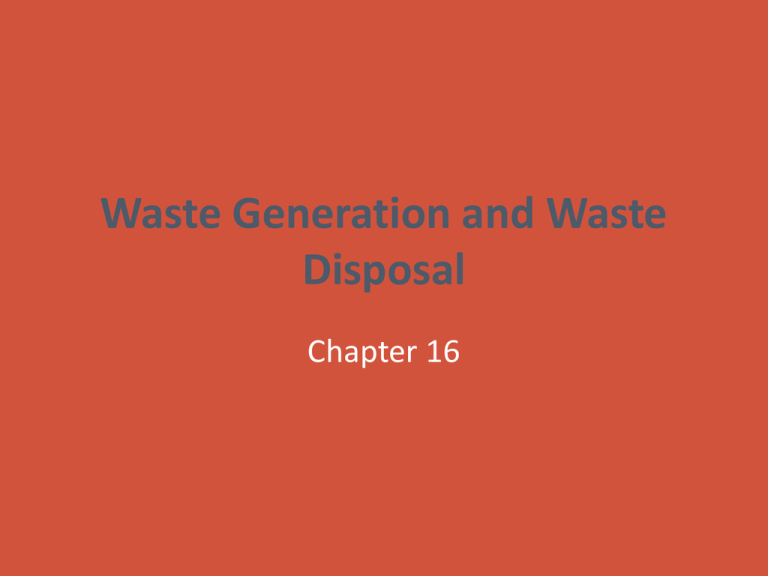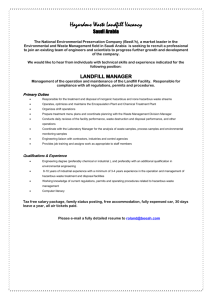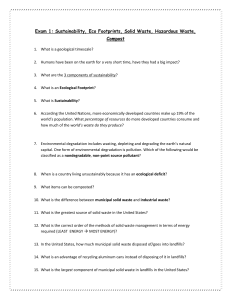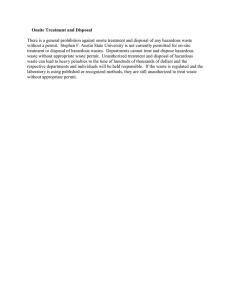Waste Generation and Waste Disposal Chapter 16
advertisement

Waste Generation and Waste Disposal Chapter 16 Waste • Waste – nonuseful products generated within the system • throw-away society • Municipal Solid Waste (MSW) - everyday items that we use and then throw away (“trash, garbage”) - waste stream The Three R’s • “Reduce, Reuse, Recycle” • Reduce a. optimal way of achieving a reduction in solid waste generation b. source reduction • Reuse a. allows material to cycle within a system longer before becoming an output b. no additional energy or resources needed • Recycle a. MSW collected and converted into new objects b. closed-loop - aluminum cans c. open-loop - plastic bottles into fleece jackets d. requires more energy than the other R’s e. last choice among the 3 R’s • Compost a. used for organic matter b. allows for controlled decomposition c. produces material that enhances soil structure, CEC, and fertility d. layer dry (brown) with wet (green) material, rotate regularly - provides ideal C:N ratio Landfills and Incineration • Landfills a. hold MSW with very little contamination of the surrounding environment • Structure of landfill a. clay or plastic lining at the bottom b. pipes collect leachate c. soil or clay is used to cover landfill when it reaches it’s capacity (can be reclaimed) d. must control inputs e. “tipping fee” 1. economic incentive 2. recyclables - no charge • Landfill siting a. soil rich in clay b. located away from sources of water and drinking supplies c. far from population centers d. consider amount of energy needed to get trucks there • Problems with landfills a. global problem – locating near populations that do not have the resources to object b. leachate contaminating water c. methane (CH4) - explosion hazard - can be used to generate electricity Landfills • Incineration a. burning waste to reduce volume and mass c. occasionally used for electricity d. volume – 90% weight – 75% • Structure of waste-to-energy incinerator a. MSW “tipped” onto platform b. transferred to furnace c. waste converted into CO2 and H2O and released into atmosphere d. ash - fly ash - bottom ash • Problems with Incinerator a. tipping fees charged b. produce ash (very toxic) c. require large amounts of MSW in order to burn efficiently Hazardous Waste • “liquid, solid, gaseous, or sludge waste material that is harmful to humans or ecosystems” • Textile production, cleaning of machinery, manufacturing of computer equipment • Handling hazardous waste a. must be treated before disposal b. treatment 1. making it less harmful to environment 2. altered through series of chemical procedures c. best option: substitute for other products or use less of product • Legislative action to hazardous waste a. Resource Conservation and Recovery Act (RCRA) - protect human health and natural environment by reducing/eliminating the generation of hazardous waste - EPA maintains list of hazardous wastes used by businesses, track it for proper disposal - modified by Hazardous and Solid Waste Amendment (HSWA) to encourage waste minimization and phase out disposal of hazardous waste on land; also increased law enforcement authorities (punishment) b. Comprehensive Environmental Response, Compensation, and Liability Act (CERCLA) - “Superfund Act” - imposes tax on chemical and petroleum industries - revenue from tax used to cleanup abandoned and nonoperating hazardous waste sites - authorizes federal government to response directly to release of substances that may pose a threat to human health or environment - EPA maintains National Priorities List (NPL) of contaminated sites that are eligible for cleanup funds * Superfund Site – Love Canal, New York c. Brownfields 1. used to assist state and local governments in cleaning up contaminated sites (actual program) 2. contaminated sites that require cleanup before being redeveloped or expanded ex) old factories, gas stations, dry cleaners 3. can sometimes remain used and contaminated • New Approaches to handling waste a. Life-Cycle analysis 1. “cradle-to-grave analysis” b. Integrated Waste Management 1.waste reduction management 2. disposal strategies 3. biggest emphasis – source reduction





